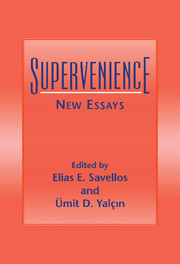Book contents
- Frontmatter
- Contents
- List of Contributors
- Introduction
- Varieties of Supervenience
- Supervenience: Model Theory of Metaphysics?
- “Global” Supervenient Determination: Too Permissive?
- Weak Supervenience Supervenes
- The Tweedledum and Tweedledee of Supervenience
- Reduction in the Mind of God
- Psychophysical Supervenience, Dependency, and Reduction
- Supervenience Redux
- Nonreducible Supervenient Causation
- Physicalism, Supervenience, and Dependence
- An Argument for Strong Supervenience
- Arguments for Supervenience and Physical Realization
- Supervenience and the Essences of Events
- How Does Ontology Supervene on What There Is?
- Supervenience and Intentionality
- Supervenience, Coherence, and Trustworthiness
- Does Truth Supervene on Evidence?
- Index
Supervenience and Intentionality
Published online by Cambridge University Press: 29 March 2010
- Frontmatter
- Contents
- List of Contributors
- Introduction
- Varieties of Supervenience
- Supervenience: Model Theory of Metaphysics?
- “Global” Supervenient Determination: Too Permissive?
- Weak Supervenience Supervenes
- The Tweedledum and Tweedledee of Supervenience
- Reduction in the Mind of God
- Psychophysical Supervenience, Dependency, and Reduction
- Supervenience Redux
- Nonreducible Supervenient Causation
- Physicalism, Supervenience, and Dependence
- An Argument for Strong Supervenience
- Arguments for Supervenience and Physical Realization
- Supervenience and the Essences of Events
- How Does Ontology Supervene on What There Is?
- Supervenience and Intentionality
- Supervenience, Coherence, and Trustworthiness
- Does Truth Supervene on Evidence?
- Index
Summary
Meanings
An attractive semantic view invokes abstract entities as the meanings of predicate expressions. According to this sort of view, people who use predicates enter into a three-term meaning relation in which a person associates a predicate with an entity that is the predicate's meaning. These entities may be Fregean senses, Platonistic properties, or some other sort of universal. The role they will have in the present inquiry is so schematic that differences among them do not matter. The idea will become clear enough from the sort of work that is supposed to be done by these ‘Meanings,’ as they will be called here.
A semantic approach that appeals to Meanings as the meanings of predicates is familiar. Let us briefly review a few important aspects of it. If it is said, for instance, that some object ‘has a spherical shape’, then this predication attributes to the object the Meaning being spherically shaped. This particular abstract entity is what is meant by the predicate, because it is the entity with which English speakers enter into the mental relation of meaning, or intending, by the predicate. Quite similarly, when someone asserts in English, ‘The Loch Ness monster is a dragon’, this is an attempt to predicate being a dragon of something that lives in Loch Ness, because that Meaning is what is intended by English speakers who predicate the expression ‘is a dragon’.
- Type
- Chapter
- Information
- SupervenienceNew Essays, pp. 273 - 292Publisher: Cambridge University PressPrint publication year: 1995



